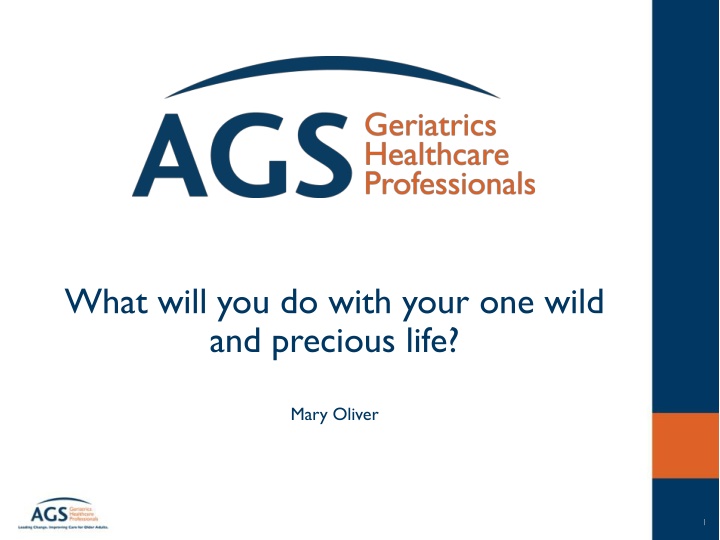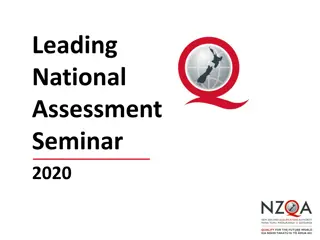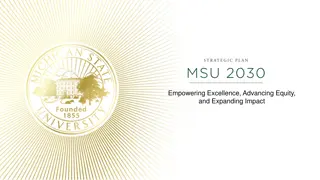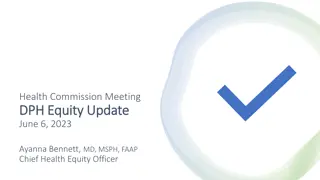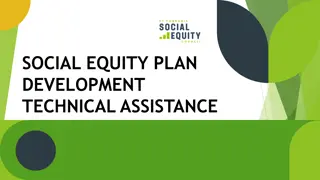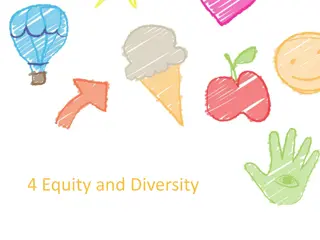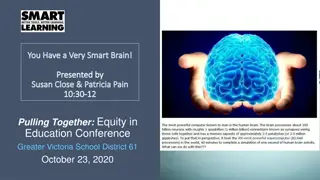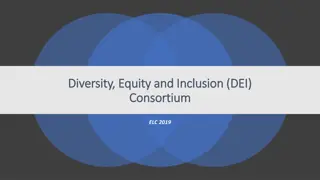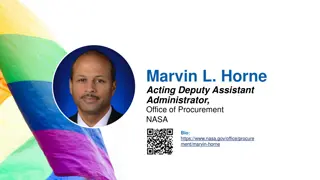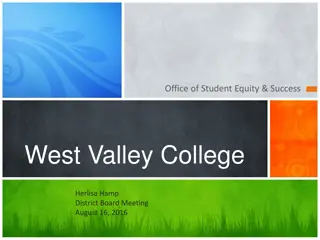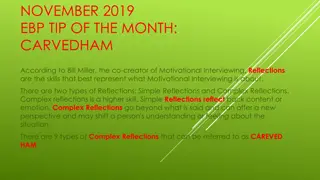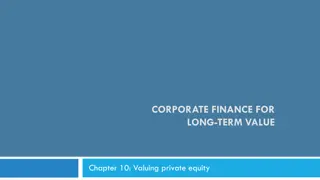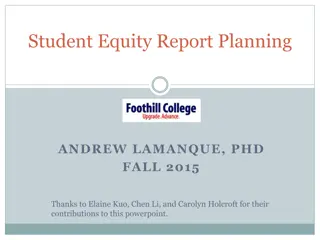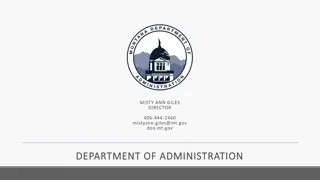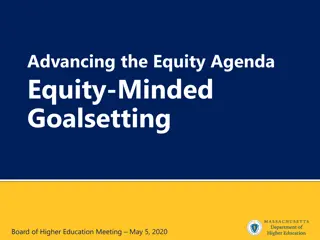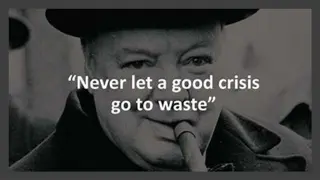Reflections on Embracing Change and Promoting Equity
In this presentation by the American Geriatrics Society, key themes include personal reflections, changing organizational approaches, and advocating for equity. The content delves into using privilege to effect change, support for marginalized communities, and addressing systemic bias in healthcare. Through personal and professional perspectives, the importance of allyship, advocacy, and inclusivity are highlighted within the context of healthcare settings.
Download Presentation

Please find below an Image/Link to download the presentation.
The content on the website is provided AS IS for your information and personal use only. It may not be sold, licensed, or shared on other websites without obtaining consent from the author.If you encounter any issues during the download, it is possible that the publisher has removed the file from their server.
You are allowed to download the files provided on this website for personal or commercial use, subject to the condition that they are used lawfully. All files are the property of their respective owners.
The content on the website is provided AS IS for your information and personal use only. It may not be sold, licensed, or shared on other websites without obtaining consent from the author.
E N D
Presentation Transcript
What will you do with your one wild and precious life? Mary Oliver 1
Who We Are Nancy E. Lundebjerg, MPA Chief Executive Officer American Geriatrics Society nlundebjerg@americangeriatrics.org Annette Medina-Walpole MD President, American Geriatrics Society Paul H. Fine Professor of Medicine Chief, Division of Geriatrics & Aging University of Rochester Medical Center Annette_MedinaWalpole@URMC.Rochester.edu We have no disclosures. 2
About this Presentation Personal Reflections Changing an Organization Intersectionality Our Approach Embedding Equity in our Definitions of Professionalism Our Commitment 3
Personal Reflection: Moving from Quiet to Vocal Ally How can I use my white privilege to achieve change? 4
Easy 5
Colleagues Friends Hard Family Patients Environment 6
Changing an Organization About the American Geriatrics Society Our nearly 6,000 members include geriatricians, geriatric nurses, social workers, family practitioners, physician assistants, pharmacists, and internists who are pioneers in advanced-illness care for older individuals, with a focus on championing interprofessional teams, eliciting personal care goals, and treating older people as whole persons. 7
AGS in the Middle of 2020 AGS Statement on the Death of George Floyd We will denounce race-related violence and will speak out against discriminatory policies. We can and must do more to address systemic racism in health care, given its impact on our patients and their families across their lifespan. We cannot stop here. President Biden 8
AGS at the End of 2020 Third Objective Added to our Future Vision We all are supported by and able to contribute to communities where ageism, ableism, classism, homophobia, racism, sexism, xenophobia, and other forms of bias and discrimination no longer impact healthcare access, quality, and outcomes for older adults and their caregivers. 9
AGS New Directions Where We Are Focuses on ageism in healthcare; Prioritizes having a diverse leadership that reflects the membership Where We Are Going Continue focus on ageism; weaving work on other isms into our core mission Undertaking a multi-year, multi-pronged project that addresses the intersection of structural racism and ageism 10
Our Focus: Intersectionality Intersectionality is a lens through which you can see where power comes and collides, where it interlocks and intersects. It s not simply that there s a race problem here, a gender problem here, and a class or LBGTQ problem there. -Kimberl Crenshaw, JD https://www.law.columbia.edu/faculty/kimberle-w-crenshaw 11
Our Approach AGS leaders took ownership of doing the work that is needed to achieve our vision; staff leadership is embedded in the CEO role We launched our intersection of structural racism and ageism initiative which has both immediate actions and longer-term strategies including: Immediate: working across portfolio of programs and products to integrate attention to equity and disparities; expanding our advocacy asks to include other forms of bias beyond ageism Longer Term: Writing groups focused on fleshing out our priorities, developing actionable strategies, and describing the intersection of structural racism and ageism We went public with a media alert, journal article We are holding ourselves accountable 12
The Thinking Behind Our Draft Priorities Modeled on a past initiative focused on geriatrics in surgical and medical specialties Aligned with our AGS strategies for achieving our future vision embed in our DNA Tapped into values we share as individuals and organizations Broad enough to allow for flexibility, future opportunities & growth Language will change as we garner feedback from members, stakeholders and allies; e.g., we will modify our increase diversity in research priority to reflect the need for meaningful community engagement in planning and conducting research 13
Personal Reflection: The Journey to Acceptance and Celebration 14
Drafted 10 Priorities that Span Five Domains Intersection of structural racism and ageism (immediate action) Increasing professional and public awareness Advancing diversity in research Incorporating diversity into professionalism, education, and training Developing our own skills as advocates 15
Identifying Actionable Strategies: Member Engagement & Gathering Ideas Convened five focus groups in March and April 2021 to brainstorm strategies individuals, internal and external to AGS Will ask for additional input via our online communities this summer We anticipate that we will continue to solicit ideas from members and look to other organizations for ideas We hope to partner with others on achieving our vision 16
Domain: Intersection of Structural Racism and Ageism AGS Priority Increase awareness among all healthcare professionals as to how they can proactively address discrimination and bias in healthcare. AGS Strategy Establish a multi-year, multi-pronged initiative focused on structural racism and ageism that supports AGS achieving its future vision of a healthcare system that is free of discrimination and bias and that is aligned with AGS strategic priorities 17
Domain: Increasing Professional and Public Awareness Sample AGS Priority Reframe negative perceptions about older people that can contribute to poor clinical care Sample AGS Strategies AGS: Develop a framework for infusing recognition that we are all aging across health professional curricula so that trainees better understand our shared humanity. An essential component would be experiences that would allow trainees to see the arc of aging across settings. Individual: Geriatrics health professionals should model behavior that respects the whole person and that is free of ageism, racism, and other forms of discrimination. 19
Domain: Advancing Diversity in Research Sample AGS Priority Expand the number of older adults participating in research across health professions, with a focus on increasing diversity in study populations. Sample AGS Strategies AGS: Develop a self-guided curriculum that supports researchers across disciplines and specialties in recruiting and retaining diverse older adults into research studies. AGS/National: Support diverse investigators to have successful careers in research 20
Domain: Developing Our Own Skills as Advocates Sample AGS Priority Improve AGS member advocacy and leadership skills so that we can all work towards meaningful change in clinical care of older adults locally. Sample AGS Strategy AGS: Develop a leadership curriculum that is focused on communication skills and that covers such topics as elevator speeches, presentation skills, effective social media with a focus on ageism and other forms of discrimination. 21
Domain: Incorporating Diversity into Professionalism, Education, and Training Sample AGS Priority Increase inclusion of the responsibility to recognize, understand and act to dismantle explicit or implicit bias as a core component of discipline-specific definitions of professionalism. Sample AGS Strategies Individual: Work within our own institutions to change recruitment, selection, and promotion criteria so that these are flexible and reflect our increasingly diverse workforce and factor in the distance traveled. 22
What will you do with your one wild and precious life? Taking Action Recognize that addressing discrimination and bias and healthcare is a responsibility that we all share. Understand our own implicit and explicit bias by assessing ourselves. Learn frameworks for racial equity and use that knowledge in our own lives. Acknowledge that we are each on a learning journey and approach this work with cultural humility. Determine how we each will take action personally and professionally. Our plans should start with where we are in our own journeys. 23
Our Commitment Engage AGS Members, Stakeholders, and Allies Learn from our mistakes Continue to listen and grow Support everyone to become a part of the solution Keep at it until the future we envision is the present we live in. 24
